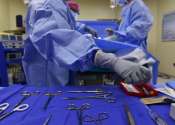Last update:
Surgery news
Oncology & Cancer
Using 3D modeling to improve the surgical outcomes for prostate cancer
Prostate cancer is often treated by a robotic keyhole surgery called a robotic-assisted radical prostatectomy. Accompanying this surgery is an MRI scan that tells the surgeon where the cancer is within the prostate.
Aug 23, 2024
0
0
Surgery
Surgery effective for thoracic ossification of posterior longitudinal ligament
For patients with thoracic ossification of the posterior longitudinal ligament (T-OPLL), surgical treatment is effective for improving neurological function, quality of life (QoL), and pain management during a 10-year period, ...
Aug 22, 2024
0
0
Cholecystectomy not always necessary for gallstones and abdominal pain, study finds
Each year, 100,000 people visit their doctor with abdominal pain, with approximately 30,000 of them diagnosed with gallstones. The standard treatment for these patients is a laparoscopic cholecystectomy. Since the 1990s, ...
Aug 21, 2024
0
1

High or low oxygen levels are safe during heart surgery: Study
Two out of 10 people who receive cardiac surgery are affected by acute kidney injury, prolonging their hospital stay and increasing their risk for chronic kidney disease, cognitive decline and heart failure.
Aug 21, 2024
0
0

Study finds sex-based disparities in outcomes after cardiac surgery
New research suggests that women who develop postoperative atrial fibrillation (poAF) after cardiac surgery are at greater risk of death than men. A study led by Mass General Brigham researchers found that women may have ...
Aug 21, 2024
0
0

Report shows fewer Australians are having bariatric surgery
Fewer Australians are having bariatric surgery, and a new report shows the results for those who do are mostly positive, including significant weight loss and big improvements for those with diabetes.
Aug 21, 2024
0
0

Modic changes linked to microbial differences in lumbar spine
Among patients undergoing lumbar spinal fusion, the presence of Modic changes is associated with differences in microbial diversity and metabolites in the lumbar cartilaginous endplates (LCEPs), reports a study in The Journal ...
Aug 20, 2024
0
0

Researcher says more validation needed for increase in gallbladder surgeries
Although surgery is a common treatment for patients diagnosed with biliary dyskinesia, or functional gallbladder disorder, a West Virginia University medical researcher is questioning why the practice has become so widespread ...
Aug 20, 2024
0
0

The FDA calls them 'recalls,' yet the targeted medical devices often remain in use
In 2016, medical device giant Abbott issued a recall for its MitraClip cardiac device—"a Class I recall, the most serious type," the FDA said.
Aug 20, 2024
0
1

Expanding a child's heart implant with light: New shunt could eliminate multiple heart surgeries
Children born with defects that impair the heart's lower chambers undergo a series of invasive surgeries early in life. The first surgery includes implantation of a plastic tube called a shunt to improve blood flow. However, ...
Aug 19, 2024
0
22

Acceptable liver transplant outcomes seen after ICI therapy for liver cancer
For patients with hepatocellular carcinoma (HCC), immune checkpoint inhibitor (ICI) use prior to liver transplant (LT) does not worsen outcomes, according to research published online July 10 in the Journal of Hepatology.
Aug 19, 2024
0
0

A moment's pause: A concept co-created by a surgeon is saving lives
Daniel Hall has shimmied gallbladders out of half-inch-wide laparoscopic incisions and performed life-saving surgeries at the VA Pittsburgh Healthcare System since 2007.
Aug 19, 2024
0
0

Retrospective study explores mitral valve surgery outcomes in atrial functional mitral regurgitation
Mitral regurgitation (MR) is a serious heart condition that often requires corrective surgery. It is characterized by the backflow or "regurgitation" of blood from the heart's left ventricle into the left atrium.
Aug 19, 2024
0
1

United Therapeutics to build pig-to-human organ research center in southeast Minnesota
This southeast Minnesota city could soon be at the forefront of efforts to use genetically modified pig organs for human transplants.
Aug 19, 2024
0
20

Australia's IV fluids shortage will likely last all year. Here's what that means for surgeries
The current shortage of sterile intravenous (IV) fluids is a serious ongoing concern for doctors across Australia. During surgery, these sterile fluids are essential to administer drugs and hydrate patients intravenously ...
Aug 19, 2024
1
0

Better transplantations with 'heart-in-a-box': Study finds method reduces early heart failure risk
The risk of early heart failure after heart transplantation is lower if the donor heart is stored in a so-called heart-in-a-box instead of in the usual cooler with ice. This is according to a study by researchers at the University ...
Aug 16, 2024
0
44

Pre-surgical antibody treatment might prevent heart transplant rejection
A new study from scientists at Cincinnati Children's suggests there may be a way to further protect transplanted hearts from rejection by preparing the donor organ and the recipient with an anti-inflammatory antibody treatment ...
Aug 12, 2024
0
21

Study shows fallopian tubes can be safely removed during sterilization surgery
Women whose fallopian tubes are removed during sterilization via laparoscopy have only marginally more surgical complications than those whose tubes are simply cut, a study shows. The removal, salpingectomy, is a safe procedure ...
Aug 12, 2024
0
13

Review suggests many men with early prostate cancer may not need lymph node removal
For years, the treatment of early-stage prostate cancers that haven't spread beyond the organ has often included the removal of nearby lymph nodes in the pelvis. It's done as a precaution and as a means of "staging" the disease.
Aug 12, 2024
0
0

VA's Disrupted Care National Project discovers vascular surgery rates still decreasing since COVID-19 pandemic
Recently published findings from the VA Disrupted Care National Project (DCNP) revealed the number of vascular surgeries performed across the United States continued to decline even after large drops during the COVID-19 pandemic.
Aug 9, 2024
0
1

Study examines impacts of long-term parasitic bladder infection on vesicovaginal fistula repair in Angola
A first-of-its-kind study led by researchers from McMaster University investigated the impact of chronic schistosomiasis, a long-term parasitic bladder infection, on the outcomes of surgery for a common, severe, and preventable ...
Aug 8, 2024
0
0

DNA fragments help detect kidney organ rejection
Findings from a study published in Nature Medicine show that donor-derived cell-free DNA (dd-cfDNA), also called liquid biopsy, has the potential for early detection of kidney transplant rejection.
Aug 7, 2024
0
15

Study shows donor kidneys with toxoplasma do not increase risks for transplant patients
A new study from UC Davis Health could help to increase the supply of donor kidneys.
Aug 7, 2024
0
22

Could awake kidney transplants become the norm?
"I saw everything," says 74-year-old Harry Stackhouse from Illinois, who was awake during his recent kidney transplant. He felt no pain as he chatted with doctors, examined the donor organ, and watched the surgical team staple ...
Aug 7, 2024
0
16

In Australia, 90,000 have hernia repair surgery each year, with older men at highest risk
A new Australian study reveals who is most at risk of having hernia repair surgery, one of the most common medical conditions and surgical operations performed in hospitals worldwide.
Aug 7, 2024
0
0













































